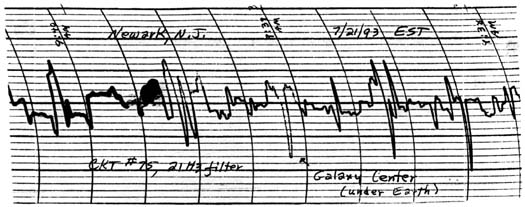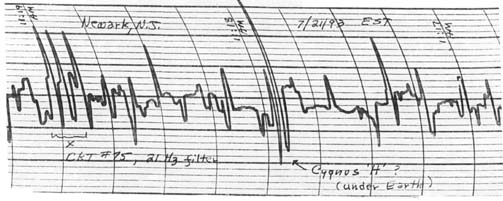Recent GW Signal Scans
(7-19-1993)
A. Recent GW Signal Scans:
The recent spate of bad weather in the USA and elsewhere is quite unexplained in conventional science. In the past we had associated some ‘strange’ weather with unusual GW signal responses. We decided to look into this since we noted:
1. A noticeable increase in the l/f background noise on the various GW detector units in recent months. This was also accompanied by some unusual variations in the averaged earth g-fields.
2. It was also noticed that the unusual weather patterns and the earthquake in Japan appeared to be centered around the 40o to 42o N. Latitudes. This is also the general area of the Cygnus region of the sky --- a known very active region optically and gravitationally!
B. Initial ‘Look’:
We began our ‘look’ by running a continuous 5-day 2-D scan of our meridian with Circuit #75 coupled to a Rustrak recorder. The purpose of this test was to see if we could ‘see’ any obvious repeating ‘structures’ in this scan period. Since each scan covers a slightly different region of the universe each day, only very strongly repeating structures were liable to repeat. Such a repeating structure seemed to occur at about RA of 19 hours and 20 minutes, and since it was always in the center of our scan sector, the probability was that it was in our zenith, i.e., in the Cygnus region! With the 2-second sampling rate of the Rustrak recorder, it is at best crude, but a definite structure appeared at this location on each approximately midnight scan, where this region was in our zenith! It is hard to see this structure, but when the chart is held at the correct distance it can stand out as a dark center with a white ring around it. It presently appears to possibly be two black holes (?) in orbit around each other, as the scans seem to change relative positions each day. Two scans from this test are shown in Figure (1).
This same region was also ‘fast’ scanned with the Esterline-Angus recorder unit, using the same experimental setup. This is also shown in Figure (1). Here it also appears to be possibly two black holes in close orbit. We have termed this structure Cygnus ‘H’ and will follow it further as time permits.
C. Retest of the Galaxy Center:
The last ‘look’ we made of the Galaxy Center using the ‘fast’ scan was better than a year ago. At that time, the GC ‘hole’ had apparently ‘evaporated’ and only showed a very faint trace of its once magnificent ‘depth’. Shown in Figure (2) is the most recent scan of this region. It seems to show that mass is recollecting there but it is far from being a black hole yet. We will resacn again in about 6 months.
D. Retest of Geminga:
There has been some reference to a soft gamma pulsar in Gemini. We had observed a black hole structure in this region for the past several years. However, our structure appeared at an RA of around 7 hours and 20 minutes, and the recent scan of this area shows our to be alive and well!
E. Conclusions:
The preliminary tests given here appear to show that GW signal astronomy techniques are alive and well also, and it is sad that they are not being more aggressively used --- we could learn more about our universe, and also, note that these signals are now, in real time, and are affecting our Earth as well as the universe in ways which are not explainable in conventional science. If these effects are responsible for our Midwest floods, there is little we can do about it, but at least we may know why!!!
Figure (1): Recent 'Fast' Scans (Esterline-Angus recorder used) ~

(a) Note: This scan was made under the same conditions as that shown in Figure (2) Note of 7-19-1993. The dense mass now collecting at the Galaxy Center again still does not appear to qualify as a 'black hole' yet. The pen of the recorder was drying out -- an attempt to refill it resulted in the 'blotting' seen above. Also note the corrected time in this scan; the time on 7-19-1993 was corrected for EST in the wrong direction!

(b) Note: This scan confirms that the structure of Cygnus 'H' may be a double 'black hole' structure which is rotating fairly rapidly (possibly only several days for a complete orbit). This will show up with the variation in the peaks of the structure. Note the interesting multi-supernovae at X. This also appears to occur often!
Figure (2): Recent Re-scans ~
(a) Fast 'scan' of the Galaxy Center (GC) as seen under Earth on the morning of 7-19-1993. The GC seems to be recollecting mass but does not seem to be a 'black hole' yet. As usual, many supernovae (SN) are 'caught' in this region.

(b) Fast 'scan' of the original 'Geminga' in Gemini. This 'black hole' has been 'seen'with no apparent change for at least the past 5 years. When time permits, we will see if we can spot the 'hole' which may be responsible for the soft gamma ray 'pulsar' reported in Gemini!
